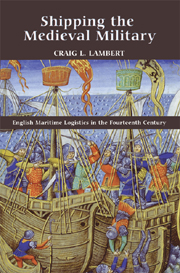Book contents
- Frontmatter
- Contents
- List of Tables
- Acknowledgments
- Abbreviations
- Introduction
- 1 Raising a Fleet
- 2 The Supply of Armies and Garrisons by Sea, 1320–1360
- 3 The Transportation of English Armies to France, 1324–1360
- 4 Maritime Resources and the King's War
- Conclusion
- Appendix 1 Ports that Supplied Ships to the Fleets
- Appendix 2 Reconstructing the Merchant Fleet: A Methodology
- Bibliography
- Index
- Warfare in History
2 - The Supply of Armies and Garrisons by Sea, 1320–1360
Published online by Cambridge University Press: 12 September 2012
- Frontmatter
- Contents
- List of Tables
- Acknowledgments
- Abbreviations
- Introduction
- 1 Raising a Fleet
- 2 The Supply of Armies and Garrisons by Sea, 1320–1360
- 3 The Transportation of English Armies to France, 1324–1360
- 4 Maritime Resources and the King's War
- Conclusion
- Appendix 1 Ports that Supplied Ships to the Fleets
- Appendix 2 Reconstructing the Merchant Fleet: A Methodology
- Bibliography
- Index
- Warfare in History
Summary
Logistics and Preparations for War: An Overview of Procedures
Logistical preparation was one of the most important and complicated aspects of any campaign. Indeed, ensuring that an army would be fully supplied with foodstuffs has been described as one of the most difficult problems faced by any medieval government. And once that army had made inroads and established garrisons, as the English did in Scotland, it was necessary also to make sure that those islands of occupation were fully supplied. Without adequate provender the intended strategy of an invading force would collapse within weeks. Once food ran out and soldiers became hungry discipline would suffer and desertions increase. This was as obvious to a medieval commander as it is to modern strategists. Therefore, royal campaigns during the Edwardian period were usually preceded by months of meticulous planning. This is not to say that in every campaign during this period everything went according to plan and the army remained continually supplied with food. The 1322 and 1327 Scottish campaigns provide stark reminders that any medieval expedition, regardless of the preparations, could disintegrate due to lack of provender. And these two campaigns were a far cry away from the comment made by the Venetian envoy in 1497 who stated that, ‘I have it on the best information that when war is raging most furiously, they (the English) will seek for good eating, and all their comforts, without thinking of what harm might befall them’.
- Type
- Chapter
- Information
- Shipping the Medieval MilitaryEnglish Maritime Logistics in the Fourteenth Century, pp. 52 - 100Publisher: Boydell & BrewerPrint publication year: 2011



